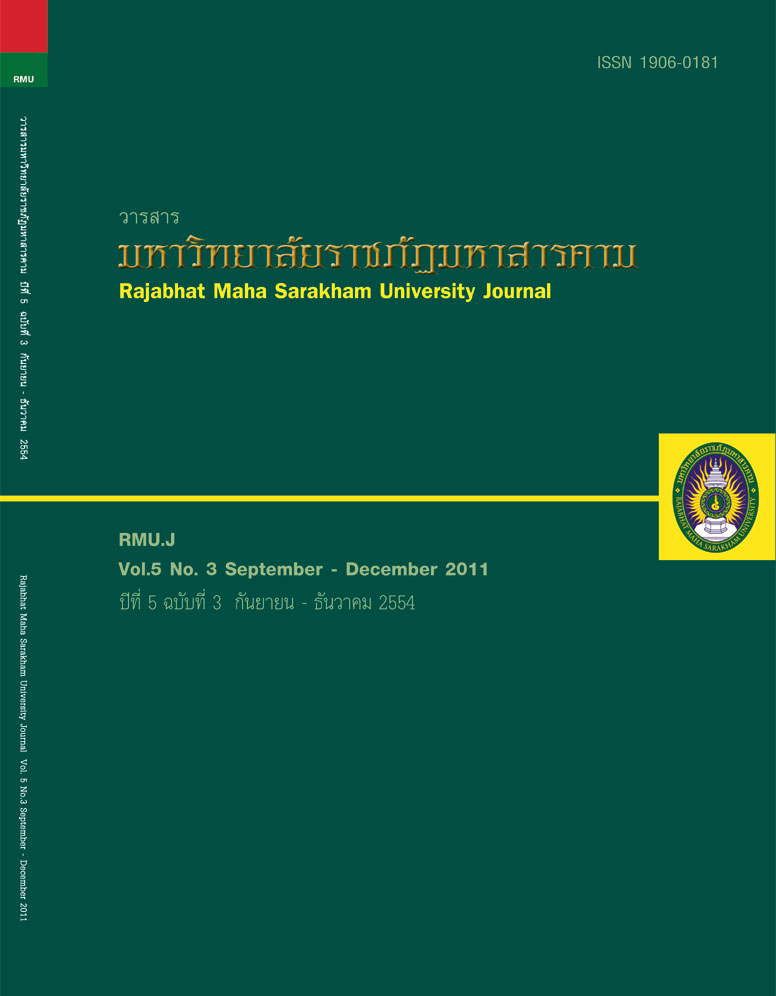Development of Learner-Centered Instructional Model in the Forth Learning Strand of Occupation and Technology (Information Technology) for the 10-12th grade Students under Maha Sarakham Educational Service Area Office 3
Main Article Content
Abstract
การวิจัยครั้งนี้มีวัตถุประสงค์ ประการแรก เพื่อพัฒนารูปแบบการจัดการเรียนรู้ที่เน้นผู้เรียนเป็นสำคัญ กลุ่มสาระการเรียนรู้
การงานอาชีพ และเทคโนโลยี สาระที่ 4 เทคโนโลยีสารสนเทศ สำหรับผู้เรียนช่วงชั้นที่ 4 สำนักงานเขตพื้นที่การศึกษามหาสารคาม ประการ
ที่สอง พัฒนากิจกรรมการเรียนรู้ตามรูปแบบการจัดการเรียนรู้ที่เน้นผู้เรียนเป็นสำคัญให้มีประสิทธิภาพตามเกณฑ์ E1/E2 ประการที่สาม
เปรียบเทียบผลสัมฤทธิ์ทางการเรยี นระหว่างผู้เรยี นที่เรียนด้วยกิจกรรมการเรียนรู้ทีพั่ฒนาขึ้นตามรูปแบบการจัดการเรียนรูที้่เน้นผูเ้ รยี น
เป็นสำคัญ และผู้เรียนที่เรียนแบบปกติ ประการที่สี่ ศึกษาความคิดในเชิงสร้างสรรค์ชิ้นงานด้านคอมพิวเตอร์ของผู้เรียนที่เรียนด้วย
กิจกรรมการเรียนรู้ที่พัฒนาขึ้นตามรูปแบบการจัดการเรียนรู้ที่เน้นผู้เรียนเป็นสำคัญ และ ประการที่ห้า ศึกษาความพึงพอใจของผู้เรียน
ที่เรียนด้วยกิจกรรมการเรียนรู้ที่พัฒนาขึ้นตามรูปแบบการจัดการเรียนรู้ที่เน้นผู้เรียนเป็นสำคัญ ประชากรที่ใช้ในการวิจัยครั้งนี้ เป็นผู้เรียน
ช่วงชั้นที่ 4 ของโรงเรียนระดับมัธยมศึกษา ในเขตจังหวัดมหาสารคาม จำนวน 37 โรงเรียนกลุ่มตัวอย่าง เป็นผู้เรียนชั้นมัธยมศึกษาปีที่
5 ภาคเรียนที่ 1 ปีการศึกษา 2552 โรงเรียนเขื่อนพิทยาสรรค์ สังกัดสำนักงานเขตพื้นที่การศึกษามหาสารคาม เขต 3 คัดเลือกโดยวิธี
เฉพาะเจาะจง เนื่องจากเป็นโรงเรียนมัธยมศึกษา ประจำตำบลขนาดเล็ก ที่มีจำนวนนักเรียนน้อยกว่า 500 คน จำนวน 2 ห้องเรียน จัด
แบ่งเป็นกลุ่มทดลองและกลุ่มควบคุมด้วยวิธีการจับฉลาก ดังนี้ 1) กลุ่มทดลอง เป็นกลุ่มที่จัดการเรียนรู้ด้วยกิจกรรมการเรียนรู้ตาม
รูปแบบที่พัฒนาขึ้น จำนวน 34 คน 2) กลุ่มควบคุม เป็นกลุ่มที่จัดการเรียนรู้แบบปกติ จำนวน 28 คน เครื่องมือที่ใช้ ได้แก่ รูปแบบ
การจัดการเรียนรู้ที่เน้นผู้เรียนเป็นสำคัญ กลุ่มสาระการเรียนรู้การงานอาชีพ และเทคโนโลยี สาระที่ 4 เทคโนโลยีสารสนเทศ สำหรับ
ผู้เรียนช่วงชั้นที่ 4 สำนักงานเขตพื้นที่การศึกษามหาสารคาม แบบประเมินความคิดเห็นของผู้เชี่ยวชาญที่มีต่อรูปแบบที่พัฒนาขึ้น กิจกรรม
การเรียนรู้ แบบประเมินกิจกรรมการเรียนรู้ แบบทดสอบวัดผลสัมฤทธิ์ทางการเรียน แบบประเมินความพึงพอใจ ของนักเรียนกลุ่ม
ทดลอง และแบบประเมินความคิดในเชิงสร้างสรรค์ชิ้นงานด้านคอมพิวเตอร์ สถิติที่ใช้ ได้แก่ ร้อยละ ค่าเฉลี่ย ส่วนเบี่ยงเบนมาตรฐาน
และค่าสถิติ t-test (Independent) ผลการวิจัยพบว่า
1. รูปแบบประกอบด้วยขั้นตอนการจัดการเรียนการสอนจำนวน 5 ขั้นตอน ได้แก่ ขั้นทบทวนความรู้ขั้นเรียนเนื้อหาใหม่ ขั้นสรุป
ความรู้/ฝึกปฏิบัติ ขั้นอภิปรายผล และขั้นการค้นคว้าเพิ่มเติม/การผลิตชิ้นงาน โดยผู้เชี่ยวชาญมีความเห็นต่อรูปแบบในระดับมาก
มาก
2. กิจกรรมการเรียนรู้ตามรูปแบบที่พัฒนาขึ้นผู้เชี่ยวชาญมีความคิดเห็นโดยรวมต่อคุณภาพกิจกรรมการเรียนรู้ในระดับมากที่สุด
และมีประสิทธิภาพตามเกณฑ์ E1/E2 เท่ากับ 85.58/83.55
3. ผลสัมฤทธิ์ทางการเรียนหลังเรียนระหว่างนักเรียนที่ได้รับการจัดการเรียนรู้ด้วยกิจกรรมการเรียนรู้ตามรูปแบบที่พัฒนาขึ้นแตก
ต่างจากผู้เรียนที่เรียนแบบปกติอย่างมีนัย สำคัญทางสถิติที่ระดับ .05
4. นักเรียนมีความคิดในเชิงสร้างสรรค์ ในระดับมากที่สุด และ
5. ความพึงพอใจของนักเรียนหลังจากได้รับการจัด การเรียนรู้ด้วยกิจกรรมการเรียนรู้ตามรูปแบบที่พัฒนาขึ้นอยู่ในระดับมาก
ที่สุด
The objectives of the research were to: firstly, develop a learner-centered instructional model of
the fourth learning strand of occupation and technology (Information Technology) for the 10-12th grade level
students under the Office of Maha Sarakham Educational Service Area, Thailand, secondly, develop the
learning activities based on the standardized criteria efficiency (E1/E2), thirdly, compare the learning
achievement between learner centered used instructional model classroom and normal classroom, fourthly,
analyze the computer skills of the students for creative thinking and fifthly, investigate the satisfaction of the
students with the learner-centered learning activities. The population was the fourth level students from 37
high schools in Maha Sarakham Province, Thailand. The subjects consisted of sixty two students of the 11th
grade on the first semester of 2009 academic year at Khuean Pitayasan High School under Maha Sarakham
Educational Service Area Office 3 by purposive sampling. They were split into two groups, selected through
simple random sampling: 34 students was an experimental group and 28 students was a control group. The
research instruments were: a learner-centered instructional model of the fourth learning strand (Information
technology), an evaluation form for the instructional model, learning activities, learning activity evaluation form,
an achievement test, a satisfaction evaluation form, and a creative thinking on computer tasks. The statistics
used for analyzing data were percentage, mean, standard deviation, and t-test (Independent Sample). The
results of the research were as follows:
1. The learner-centered instructional model consisted of 5 steps: review of previous knowledge,
presentation of new knowledge, conclusion and practice, discussion, and further study or additional
study. The average opinion of the experts towards the instructional model was at a high level.
2. The overall of the quality of the instructional model was at the highest level. The efficiency regarding
the standardized criteria E1/E2 was at 85.58/83.55.
3. The average score of the students who studied with the learner-centered activities was
significantly higher than those of the normal classroom at the .05 level.
4. The finding indicated that the average level of the creative thinking on computer tasks was the
highest level.
5. Regarding the satisfaction, it showed that the average level of the satisfaction of the students
with the instructional model was the highest level.
Article Details
1. All articles undergo a thorough with at least three reviewers evaluating their suitability within the respective field of study, during the double-blind review.
2. The views expressed by individual authors do not represent the official views of the Editorial Boards of RMUJ: The author of each articie is responsible for all its contents.
3. The Editorial Boards do not reserve the copyrights. but proper citations need to be made.


